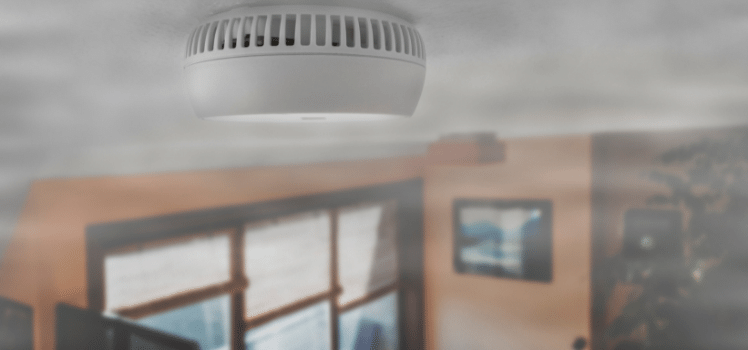The Smoke and Carbon Monoxide Alarm (England) Regulations are changing. The regulations, originally enforced in 2015, were amended from 1 October 2022 and apply to both private and social rental properties.
- What are the new rules for smoke and carbon monoxide alarms?
- What type of smoke and carbon monoxide alarm do I need?
- Where should I put my smoke and carbon monoxide alarms?
- What is a fixed fuel appliance?
- What properties and tenancies fall under the regulations?
- What are the rules for smoke and carbon monoxide alarms in Wales?
- Who’s responsible for smoke and carbon monoxide alarms?
- What if I don’t have a smoke or carbon monoxide alarm?
- How can landlords show they are compliant?
- What other safety responsibilities do landlords have?
Instant Rental Price Estimator
Discover your property’s true rental value in seconds with our free, UK-wide price comparison tool.
What are the new rules for smoke and carbon monoxide alarms?
From 1 October 2022, both private and social rentals must have at least one working smoke alarm on each storey where there is a room used as living accommodation. This has been a legal requirement for private rental properties since the first regulations in 2015, but will now apply to social housing as well.
There must be a carbon monoxide alarm in any room used as living accommodation which contains a fixed combustion appliance. This is any appliance that uses fuel to generate heat, but excludes gas cookers.
Perhaps the biggest change for landlords is that they will be responsible for repairing or replacing any smoke and carbon monoxide alarms once they are informed by their tenant. Before the amended regulations, landlords are currently responsible for installing and testing the alarm at the start of the tenancy – but it is the tenant’s default responsibility to repair or replace it during the tenancy.
What type of alarm is required for the smoke and carbon monoxide rules?
There is no specific alarm type stipulated in the regulations for either smoke or carbon monoxide alarms.
It’s up to the landlord to decide based on the needs of their building and tenants. Mains powered (hard wired) or battery powered are perfectly fine, as long as they are compliant with British Standards BS 5839-6 (smoke alarms) and British Standards BS 50291 (carbon monoxide alarms).
Where battery-powered alarms are selected, alarms with ‘sealed for life’ batteries rather than alarms with replaceable batteries are the better option. Heat detectors are not considered a replacement for smoke alarms.
Landlords should consider their tenant’s individual circumstances when choosing the best alarm. For example, if residents are deaf or hard of hearing, alarms which alert by vibration or flashing lights (instead of sound) would be more suitable.
Where should smoke and carbon monoxide alarms be located?
At least one smoke alarm should be installed on every storey which is used as living accommodation. The regulations do not stipulate where exactly they should be fitted or placed, but they are generally fixed to the ceiling in a circulation space, i.e. a hall or a landing.
There is no stipulation for carbon monoxide alarms other than ensuring they are installed in every room which is used as living accommodation containing a fixed combustion appliance (excluding gas cookers).
Carbon monoxide alarms should be positioned at head height, either on a wall or shelf, approximately 1-3 metres away from a potential source of carbon monoxide. Individual manufacturer’s instructions should be followed for both smoke and carbon monoxide alarms.
What is a fixed combustion appliance?
Carbon monoxide alarms must be installed in any room containing any fixed combustion appliance, except gas cookers. This means a fixed apparatus where fuel of any type is burned to generate heat.
These appliances are typically powered by gas, oil, coal, wood, etc. such as gas or oil boilers, or log-burning stoves. A non-functioning decorative fireplace would not be considered a fixed combustion appliance.
What tenancies do the regulations apply to?
The regulations apply to tenancies for all homes rented by private landlords or registered providers of social housing in England. The following tenancies are excluded:
- shared accommodation with a landlord or landlord’s family
- long leases
- student halls of residence
- hotels and refuges
- care homes
- hospitals and hospices
- low-cost ownership homes
- other accommodation relating to health care provision
If the occupier shares the accommodation with the private landlord or the private landlord’s family, these regulations will not apply. The regulations do not apply to owner-occupiers or owner-occupiers living in shared-ownership homes.
What are the smoke and carbon monoxide alarm rules in Wales?
These regulations do not apply to Welsh properties, but the Renting Homes (Wales) Act 2016 has similar provisions regarding carbon monoxide alarms.
To ensure all properties are fit for human habitation, a carbon monoxide alarm must be placed in every room with a solid fuel-burning appliance and a smoke alarm is required on every storey. This law will come into place on 1 December 2022. Read more about the Renting Homes (Wales) Act here.
Smoke and carbon monoxide alarms: what are landlords responsible for?
Landlords are responsible for ensuring the correct alarms are installed and in working order. Landlords must test the alarm on the day the tenancy begins and repair or replace any faulty alarms reported by the tenant during the tenancy.
Tenants are responsible for reporting issues with smoke or carbon monoxide alarms, but it is wise for landlords to check them during mid-term inspections or other routine visits. For battery-powered alarms, tenants should replace the batteries themselves. If the alarm still doesn’t work, or the tenant is unable to replace the batteries, they should report this to the landlord.
How are the alarm regulations enforced?
The regulations will be enforced by local housing authorities. If landlords are made aware that they are not compliant, they should take action to install or repair the alarms as soon as possible.
The local housing authority may serve a remedial notice to landlords found in breach of the regulations. Failure to comply with each remedial notice can lead to a fine of up to £5,000 per breach, rather than per landlord or property.
How can landlords prove compliance?
Landlords should keep a record of when alarms are installed, tested and repaired. If queried, the local housing authority will decide whether the evidence proves that the landlord met the requirements.
Carrying out an inventory on the first day of the tenancy is a good way to keep a record. The landlord – or the inventory clerk – can note that alarms have been tested and are working, then the tenant can sign the inventory to confirm it’s correct.
What other safety responsibilities do landlords have?
Ensuring the rental property has a smoke and carbon monoxide alarm is just a small part of a landlord’s safety responsibilities. They must also ensure their property has the following:
- Annual gas safety check and record
- Electrical check and EICR every five years
- Valid energy performance certificate
What do you think?
What do you think about the amended smoke and carbon monoxide alarm regulations? Share your thoughts in the comments below.



